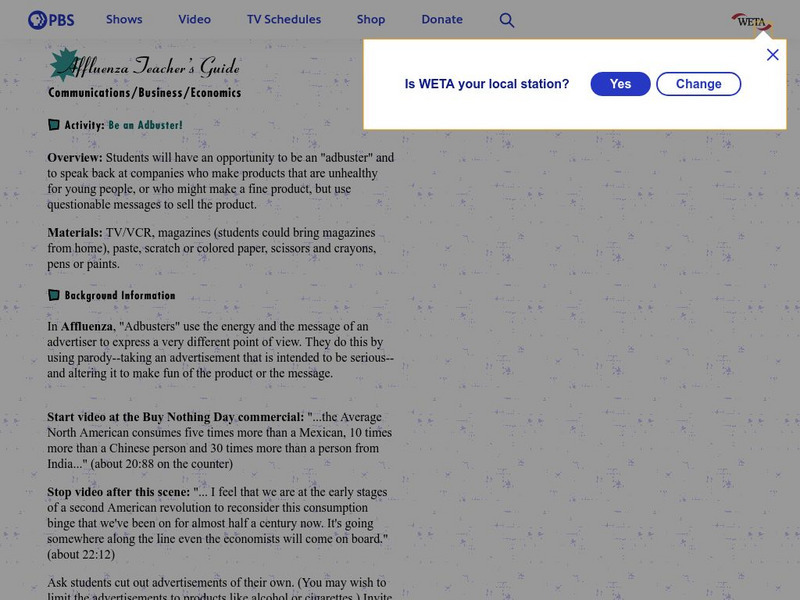Hi, what do you want to do?
Curated OER
Scenario Challenge: Farenheit 451
Students choose books to preserve for future generations. Students are given a scenario in which they are allowed to save only five books for future generations. Students write a persuasive letter in which they try to...
Curated OER
Convince Me!
Students analyze advertisements meant to persuade a reader to purchase a certain product or service to find out what stands out about the ad or what it is about the ad that persuade readers. They complete an analysis chart, and discuss...
Curated OER
Pod Cast Responses
Students list to a pod cast. In this listening comprehension lesson, students listen to a pod cast and respond to comprehension questions.
Curated OER
Critique Sources
Students distinguish between primary and secondary sources. They study about fact, opinion, and recognize bias. Students find out if information is accurate or not and report on it. For the final project students create an annotated...
Curated OER
Why is It That Johnny Can't Read?
Students listen to and discuss Don Henley's song, "Johnny Can't Read" and the 10,000 Maniacs song, "Cherry Tree." They research reading literacy and find statistics, evidence, stories, facts, and sources which will support their beliefs...
Curated OER
Ugly? Says Who?
Students explore biology by writing animal poetry in class. In this animal characteristics lesson plan, students research the Internet for facts about an "ugly" animal such as a bug or small critter. Students complete worksheets about...
Curated OER
Children's March Teacher's Guide, Activity 6
Students see the role that different genders played in the Civil Rights Movement in Birmingham. They explain how popular culture influences them.
Curated OER
Cartoons for the Classroom: Loosing Patients with the Recovery
Upper graders examine this political cartoon in order to better understand feelings toward the economic recovery. There are three discussion questions to accent the learning.
Curated OER
Banpo Village: Gone, But Not Forgotten
Sixth graders plan a trip to China and prepare yourself for the Banpo excavation site competition by studying prehistoric and ancient Chinese history.
Curated OER
Sweet Clara and the Freedom Quilt: The Real Story
Students learn how slaves communicated with each other. In this slavery and freedom lesson, students learn how slaves used quilts as maps, learn what different quilt patterns meant, draw a picture for their class freedom quilt and...
Curated OER
Heroes Portrait
Eighth graders investigate art appreciation and Renaissance portraits through time. They create a portrait.
Curated OER
Cartoons for the Classroom: Nothing is More Patriotic Than Social Criticism
In this historical events worksheet, learners analyze political cartoons that feature social criticism. Students respond to 2 talking point questions.
Curated OER
Reading Comprehension Assessment
In this reading assessment worksheet, students complete a 42 question, four story passages test. Students read about Stephen Spielberg, Lois Lowry, a shy boy in high school, and Haleakala volcano. Students answer the multiple choice...
Curated OER
United States Entry into World War I: Some Hypotheses About U.S. Entry
High schoolers take a stand on a hypothesis for U.S. entry into World War I, supported by specific evidence.
Wisc-Online
Wisc Online: The You View
Students will write effective business messages that incorporate a second-person point of view and focus on the benefit to the reader. This approach is often used to create positive messages, neutral messages, and inquiry messages in...
PBS
Pbs Lesson Plan (Affluenza): Be an Adbuster
Through an integrated approach from PBS, students examine the messages conveyed in print advertisements. Using parody, students are asked to alter the message of an ad to present a different or opposite point of view. Lesson may be more...
ReadWriteThink
Read Write Think: Review Redux: Literary Criticism Through Reception Moments
Literature takes on a life of its own as students take a hands-on approach to exploring A Raisin in the Sun for cultural and historical context.
PBS
Pbs Teachers: Analyzing Election Cartoons (Lesson Plan)
A lesson that helps learners identify symbols and caricature in political cartoons. Students will analyze how political cartoons portray messages, opinions, and points of view and will then compare them with written editorials.
Alabama Learning Exchange
Alex: Franklin D. Roosevelt's Pearl Harbor Address
The viewing goals for this lesson were for students to use a visual text, Franklin D. Roosevelt's "Day of Infamy" speech (played first without sound), to identify visual cues & understand why he may have chosen to use certain...
Council for Economic Education
Econ Ed Link: Did You Get the Message?
Advertising is the primary tool used by businesses to tell consumers about the goods and services they sell in the marketplace. Businesses also use advertising to try to convince consumers to buy what they are selling. Advertisements do...























